Med Surg 2→PRIORITY TWO. (110 Questions and Answers- ALL CORRECT) 2020-2021
Document Content and Description Below
Med Surg 2021→PRIORITY TWO 1. A nurse is assessing a client who is 12hr postoperative following a colon resection. Which of the following findings should the nurse report to the su rgeon? a. Heart r... ate 90/min b. Absent bowel sounds c. Hgb 8.2 g/dl d. Gastric pH of 3.0 Rationale: Normal Hgb is 13-18M g/dl, 12-16 g/dl. This may indicate a possible hemorrhaging. 2. A nurse is caring for a client who has diabetes insipidus. Which of the following medications should the nurse plan to administer? a. Desmopressin b. Regular insulin c. Furosemide d. Lithium carbonate Rationale: Diabetes Insipidus has decreased ADH. Administer Desmopressin/Vasopressin increase ADH and to stop patient on urinating. 3. A nurse is admitting a client who has arthritic pain and reports taking ibuprofen several times daily for 3 years. Which of the following test should the nurse monitor? a. Fasting blood glucose b. Stool for occult blood - GI bleed c. Urine for white blood cells d. Serum calcium Rationale: ATI Pharm 16. Pg. 485 Ibuprofen (NSAIDs) monitor for GI bleed (bloody, tarry stools, abdominal pain). 4. A nurse in the emergency department is assessing a client. Which of the following actions should the nurse take first (Click on the “Exhibit” button for additional information about the client. There are three tabs that contain separate categories of data.) a. Obtain a sputum sample for culture b. Prepare the client for a chest x-ray c. Initiate airborne precautions d. Administer ondansetron. Rationale: No idea what the Exhibit is all about; won’t be able to answer it. 5. A nurse is contacting the provider for a client who has cancer and is experiencing breakthrough pain. Which of the following prescriptions should the nurse anticipate? a. Transmucosal fentanyl b. Intramuscular meperidine c. Oral acetaminophen d. Intravenous dexamethasone Rationale: ATI pg. 27 Morphine sulfate and fentanyl are opioid agents used to treat moderate to severe pain. A short-acting pain medication is administered for breakthrough pain. 6. A nurse is admitting a client who reports chest pain and has been placed on a telemetry monitor. Which of the following should the nurse analyze to determine whether the client is experiencing a myocardial infarction? a. PR interval b. QRS duration c. T wave d. ST segment Rationale: ST elevation indicates MI. ST depression indicates ischemia 7. A nurse is teaching a client who has ovarian cancer about skin care following radiation treatment. Which of the following instructions should the nurse include? a. Pat the skin on the radiation site to dry it b. Apply OTC moisturizer to the radiation site c. Cover the radiation site loosely with a gauze wrap before dressing d. Use a soft washcloth to clean the area around the radiation site Rationale: pg. 584. Dry the area thoroughly using patting motions. 8. A nurse is caring for a client who is receiving a blood transfusion. The nurse observes that the client has bounding peripheral pulses, hypertension, and distended jugular veins. The nurse should anticipate administering which of the following prescribed medications? a. Diphenhydramine b. Acetaminophen c. Pantoprazole d. Furosemide Rationale: S/S may indicate fluid retention or heart failure. It is important to administer diuretics to prevent cardiovascular/respiratory distress. 9. A nurse is assessing a client who is receiving magnesium sulfate IV for the treatment of hypomagnesemia. Which of the following findings indicates effectiveness of the medication? a. Lungs clear b. Apical pulse 82/min c. Hyperactive bowel sounds d. Blood pressure 90/50 mm Hg Rationale: pg. 278 Confirmed on answer sheet 10. A nurse is reviewing a client’s ABG results pH 7.42, PaC02 30 mm Hg, and HCO3 21 mEq/L. The nurse should recognize these findings as indication of which of the following conditions? a. Metabolic acidosis b. Metabolic alkalosis c. Compensated respiratory alkalosis d. Uncompensated respiratory acidosis Rationale: because the HCO3 21 trying to compensate for respiratory alkalosis. 11. A nurse is caring for a client who has a deep partial thickness burns over 15% of her body which of the following labs should the nurse expect during the first 24 hours A. Decreased BUN (elevated due to fluid loss) B. Hypoglycemia (High due to stress) C. Hypoalbuminemia (Low due to fluid loss) D. Decreased Hematocrit (Elevated due to 3rd spacing during resuscitation phase) Rationale: Pg. 481 ATI. Total protein and albumin- low due to fluid loss. 12. A nurse is caring for a client who has dumping syndrome following a gastrectomy, which of the following actions should the nurse takes? a. Offer the client high carbohydrate meal options (High fat, high protein, low fiber, low to moderate carbs page 317, chapter 49 Peptic ulcer disease med surg ATI PDF 10.0) b. Provide the client with four full meals a day (Small frequent meals) c. Encourage the client to drink at least 360 ml of fluids with meals (Eliminate liquids with meals for 1 hr. prior and following a meal) d. Have the client lie down for 30 minutes after meals (Lying down after a meal slows the movement of food within the intestines) Rationale: ATI pg. 318 Dumping syndromes is a term that refers to a constellation of vasomotor symptoms that occurs after eating, especially following a Billroth II procedure. Early manifestations usually occur within 30 minutes of eating and include vertigo, tachycardia, syncope, sweating, pallor, palpitations, and the desire to lie down. The nurse should instruct the client to decrease the amount of fluid taken at meals and to avoid high-carbohydrate foods, including fluids such as fruit nectars; to assume a low-Fowler's position during meals; to lie down for 30 minutes after eating to delay gastric emptying; and to take antispasmodics as prescribed. 12. A nurse is teaching a group of young adult clients about risk factors for hearing loss. Which of the following factors should the nurse include in the teaching? a. Born with a high weight b. Chronic infections of the middle ear c. Use a loop diuretic such as furosemide and antibiotics like aminoglycoside and gentamicin leads to ototoxic medication d. Perforation of the eardrum e. Frequent exposure to low volume noise Rationale: Peds ATI pg. 77 Exposure to loud environmental sounds. Hearing defects can be caused by a variety of conditions, including anatomic malformation, maternal ingestion of toxic substances during pregnancy, perinatal asphyxia, perinatal infection, chronic ear infection, and ototoxic medications. 13. A nurse is preparing to administer fresh frozen plasma to a client. Which of the following actions should the nurse take? a. Administer the plasma immediately after thawing b. Transfuse the plasma over 4 hours (Can be in 2 to 4 hours) c. Hold the transfusion if the client is actively bleeding (YOU HAVE TO GIVE IT. That’s the whole point! The patient is losing blood so you have to replace it. We give fresh frozen plasma because he or she may have clotting deficiencies) d. Administer the transfusion through a 24-gauge saline lock (Has to be an 18 or 20 gauge) Rationale: Saunders pg. 164 Fresh-frozen plasma 1. Fresh-frozen plasma may be used to provide clotting factors or volume expansion; it contains no platelets. 2. Fresh-frozen plasma is infused within 2 hours of thawing, while clotting factors are still viable, and is infused over a period of 15 to 30 minutes. 3. Rh compatibility and ABO compatibility are required for the transfusion of plasma products. 4. Evaluation of an effective response is assessed by monitoring coagulation studies, particularly the prothrombin time and the partial thromboplastin time, and resolution of hypovolemia. 14. A nurse is assessing a client who reports numbness and tingling of his toes and exhibits a positive TROUSSEAU. Which of the following electrolyte imbalance should the nurse suspect? a. Hyponatremia b. Hyperchloremia c. Hypermagnesemia d. Hypocalcemia Rationale: (Ch. 44 page 277 MS ATI PDF 10.0)Positive s/s of Chvostek’s or Trousseau sign indicates HYPOCALCEMIA. 15. A home health nurse is teaching a client how to care for a peripherally central catheter in his right arm. Which of the following statements should the nurse include in the teaching? a. Change the transparent dressing over the insertion site every 48 hours - transparent dressing can be up to 7 days b. Clean the insertion site with mild soap and water - when showering, must insertion site must be covered!!!!! No water can be in it. c. Measure your right arm circumference once weekly- does not say in the chapter d. Use a 10-milliliter syringe when flushing the catheter Rationale: (Chapter 27 cardiovascular diagnostics and therapeutic procedures p. 166 MS ATI PDF 10.0)Usetransparent dressing to allow for visualization. Follow facility protocol for dressing changes, usually every 7 days and when indicated (wet, loose, soiled).Shower, cover dressing site to avoid water exposure. Follow the Infusion Nurses Society (INS) practicerecommendations for flushing. Use a 10-mL syringe for flushing the PICC line. Do not apply force if resistance is met. 16. A nurse is caring for a client who has a central venous access device. Which of the following assessment findings should the nurse report to the provider? a. RBC count of 4.7 million/mm (4.5-5. 3M; 4.1-5.1) b. BUN 22-mg/ dl – (5-25 mg/dl) 10-20 c. WBC count of 16,000/ mm 3à Elevated; phlebitis is a complication; infection is a complication that can happen 7 days after insertion, also temp increase if 1 degree can happen (5,000-10,000) d. Blood glucose of 120 mg/dl (70-110) Rationale: (P.166 MS ATI PDF 10.0) central venous INFECTION 17. A nurse is providing dietary teaching to a client who has chronic kidney disease and a decreased glomerular filtration rate. Which of the following statements by the client indicates an understanding of the teaching? a. I will spread my protein allowances over the entire day b. I should increase my intake of canned salmon to three times per week (NO SODIUM) c. I will season my food with lemon pepper rather than salt (We do not want to give the dietary sodium, potassium, phosphorus, and magnesium. I don’t know what lemon pepper has, but we want to RESTRICT sodium, potassium, phosphorus and magnesium.) d. I should limit my intake of hard cheese to 3 ounces each day (NO SODIUM) Rationale: (p.382 chapter 59) Rationale: ATI MS pg. 382-control protein intake based on the client’s stage of CKD and type of dialysis. Restrict sodium intake to prevent fluid retention and hypertension Low GFR indicates CRD. 18. A nurse is caring for a client who has a peripherally inserted central catheter. The client is receiving an antibiotic via intermittent IV bolus. Which of the following actions should the nurse take? a. Administer 20 ml of 0.9 sodium chloride after each dose of medication à (you only flush with 10 ml of NS, not 20. 20 is for flushing blood) b. Flush the catheter using a 5-ml syringe à you use a 10mL syringe to flush c. Verify the placement with an x-ray prior to the initial dose (POSTPROCEDURE) d. Change the transparent membranes dressing daily (dressing can last for up to 7 days) Rationale: (PAGE 166 Ch. 27 MS ATI PDF 10.0 19. A nurse is teaching a client using a metered dose rescue inhaler. Which of the following statements should the nurse include in the teaching? a. Do not shake your inhaler before use à shake 5-6x. b. Exhale fully before bringing the inhaler to your lips c. Depress the canister after you inhale (depress the inhaler as the patient inhales to go in the lungs). d. Use peroxide to clean the mouthpiece if your inhaler (mild soap and water) Rationale: Pharm ATI pg. 7 Review TABLE for administration of MDI. For an MDI, instruct the client to: ». Remove cap from inhaler. ». Shake inhaler five to six times. ». Hold inhaler with mouthpiece at the bottom. ». Hold inhaler with thumb near mouthpiece and index and middle fingers at top. ». Hold inhaler approximately 2 to 4 cm (1 to 2 in) away from front of mouth. ». Take a deep breath, and then exhale. ». Tilt head back slightly, and press inhaler. While pressing inhaler, begin a slow, deep breath that should last for 3 to 5 seconds to facilitate delivery to the air passages. ». Hold breath for 10 seconds to allow medication to deposit in airways. ». Take inhaler out of mouth, and slowly exhale through pursed lips. ». Resume normal breathing. 20. A nurse is assessing the pain status of a group of clients. Which of the following findings indicate a client is experiencing referred pain? a. A client who has angina reports substernal chest pain b. A client who has pancreatitis reports pain in the left shoulder referred pain is pain that is felt in another place that is not in the same area as where the pain should be felt. Pain radiates on a certain location of the body. c. A client who is postoperative reports incisional pain d. A client who has peritonitis reports generalized abdominal pain Rationale: ATI MS (page 30) Visceral: in internal organs such as the stomach or intestines. It can cause referred pain in other body locations separate from the stimulus. 21. A nurse is caring for a client who has just returned from surgery with an external fixator to the left tibia. Which of the following assessments findings requires immediate intervention by the nurse? a. The client reports a pain level of 7 on a scale from 0 -10 at the operative site. (The patient just came from surgery so pain is normal for post op patients for first couple of hours.) b. The client’s capillary refill in the left toe is 6 seconds (signs and symptoms of compartment syndrome) ABCs are compromised. (Cap refill should be below 3 seconds. This is s/s for compartment syndrome. Untreated can lead to necrosis.) c. The client has an oral temperature of 38.3 (100.9 F) (I wouldn’t pick this because I always see temp 101 as a priority from previous rationales with other ATIs.) d. The client has 100 ml of blood in the closed suction drained. (I believe this is normal for post-op patients.) Rationale: (p .456 MS ATI PDF 10.0 chapter 71) Assess 5 P’s: pain, paralysis, paresthesia, pallor, pulselessness 22. A nurse is assessing a client who has acute pancreatitis and has been receiving total parenteral nutrition for the past 72 hours. Which of the following findings requires the nurse to intervene? a. Right upper quadrant pain (patient has acute pancreatitis, so it’s normal) b. Capillary blood glucose level of 164 mg/dl - glucose not significantly high c. WBC counts 13,000/mm3 (Infection is one complication of TPN administration d. Crackle in bilateral lower lobes (Priority, FVE/fluid shifts to the lungs may lead to respiratory distress/collapse/failure) life threatening than infection. May need to decrease ml/hr. and assess. Rationale: (chapter 47 page 299 MS ATI PDF 10.0) (ABC’s compromised, also one of the complications of TPN is fluid imbalance aka fluid volume excess.) 23. A nurse is caring for a client who has hypotension, cool and clammy skin, tachycardia, and tachypnea. In which of the following positions should the nurse place the client? a. Reverse Trendelenburg (page 232 says for hypotension patients must be flat with legs elevated to increase venous return.) b. Side Lying c. High Fowlers d. Feet elevated Rationale: Manifestations of Heart failure/Cardiogenic Shock Pg. 195. Chapter 31 MS ATI PDF 10.0) 24. A nurse is caring for a client who has tuberculosis and is taking rifampin. The client reports that her saliva has turned red-orange in color. Which of the following responses should the nurse make? a.) “This finding may indicate possible medication toxicity” b.) “Your provider will prescribe a different medication regimen” c.) “This is an expected adverse effect of this medication.” d.) “You will need to increase your fluid intake to resolve this problem” Rationale: pg. 137 ATI MS Expected to be orange in rifampin: urine/secretions 25. A nurse is preparing to administer a unit of packed RBCs for a client who is receiving a continuous IV infusion of 5% dextrose in water. Which of the following actions should the nurse take? a.) Administer the unit through secondary IV tubing (Y-ports) b.) Verify the blood product with assistive personnel (another RN) c.) Begin an IV infusion of 0.9% sodium chloride d.) Insert another 22-gauge IV catheter (18-20 gauge is recommended. 22 is too small) Rationale: ATI Pharm pg. 355 Insert an intravenous (IV) line and infuse normal saline; maintain the infusion at a keep-vein-open rate. An 18- or 19-gauge IV needle will be needed to achieve a maximum flow rate of blood products and to prevent damage to red blood cells; if a smaller gauge needle must be used, red blood cells may be diluted with normal saline (check agency procedure). Use only 0.9% sodium chloride solution to administer with blood products; prime IV and blood tubing with this solution. Use a blood filter for most blood products and either a Y-type or straight tubing set depending on facility policy. 26. A nurse is planning care for a client who is 12 hr. postoperative following a kidney transplant. Which of the following actions should the nurse include in the plan of care? a.) Check the client’s blood pressures every 8 hr. b.) Administer opioids PO c.) Assess urine output hourly ---à prevent shock and mods d.) Monitor for hypokalemia as a manifestation of acute rejection Rationale: Pg. 374 28. A nurse is obtaining a medication history from a client who is to start therapy with naproxen for rheumatoid arthritis. Which of the following medications places the client at risk for bleeding? a.) Captopril –ace inhibitor b.) Ibuprofen --NSAIDs c.) Digoxin antidysrhythmic d.) Phenytoin-seizure 30. A nurse is assessing the extremities of a client who has Raynaud’s disease. Which of the following findings should the nurse expect? a.) Blanching of the hands REYNAUD PHENOMENON b.) Hyperactive reflexes c.) Calf pain with foot dorsiflexion d.) Vitiligo on affected extremities Rationale: (P 558 ATI MD pdf 10.0) Episodic vasospasm in the small peripheral arteries and arterioles, precipitated by exposure to cold or stress usually affects the hands or less often the feet. CREST Calcinosis- calcium deposits in the skin Raynaud phenomenon- spasm of blood vessels in response to cold or stress Esophageal dysfunction- acid reflux and decease in mortality of esophagus Scierodactyly- thickening and tightening of the skin on the fingers and hands Telangiectasias- dilation of capillaries causing red marks on surface of skin. 31. A nurse is caring for a group of clients. The nurse should obtain a blood pressure reading using only the left extremity from which of the following clients? a. A client who has a peripherally inserted central catheter in the left arm b. A client who has left-sided Bell’s palsy c. A client who has a right upper extremity arteriovenous fistula d. A client who has right-sided weakness due to Parkinson’s disease 32. A nurse is providing teaching to a client who has DVT. Which of the following findings should the nurse identify as a risk factor for the development of DVTs? a. Hypertension b. Cirrhosis c. NSAIDS use d. Oral Contraceptive Use Rationale: page 141 of ATI Book 2016 33. A nurse is caring for client who has Cushing’s disease. Which of the following actions should the nurse take first? (Click Exhibit button for additional information) a. Check the client’s medication administration record for antihypertensive medication. b. Verify the client’s understanding of sodium restriction. c. Auscultate the client’s lung sound - due to fluid retention; action first varies on the exhibit d. Determine the need for further glucose monitoring. Rationale: Unable to answer. Can’t see the exhibit. But on the chapter of Cushing disease they talk about monitoring of glucose. The rest are not stated in the chapter. 34. A nurse is assessing a client who has nephrotic syndrome. Which of the findings should the nurse expect? a. Proteinuria b. Flank pain c. Hyperalbuminemia d. Hypotension Rationale: Lewis book page 1075. Clinical manifestation of N.S.: peripheral edema, massive proteinuria, HTN, hyperlipidemia, and hypoalbuminemia. 35. A nurse is assessing a client who has right-sided heart failure. Which of the following assessment findings should the nurse expect to find? a. Oliguria (Left) b. S3/S4 galloping heart sounds (Left) c. Poor skin turgor d. Pitting edema Rationale: Page 198 Chapter 32 of ATI Book. Additional source pg. 363 36. A nurse is caring for a client who has newly inserted chest tube. The nurse should clarify which of the following prescriptions with the provider? a. Notify the provider when tidaling ceases. (Yes notify) b. Assisting the client out of bed three times daily. c. Vigorously strip the chest tube twice daily. (Vigorously and BID) d. Administer morphine 2 mg IV bolus every 3 hr. PRN for pain. (Don’t need to clarify) Rationale: Page 104 chapter 18 of ATI Book it says that: “Do not strip or milk tubing; only perform when prescribed. Stripping creates a high negative pressure and can damage lung tissue. Stripping tube of clots 37. A nurse is teaching a client who is taking an ACE inhibitor for heart failure. Which of the following instructions should the nurse include for home management of heart failure? a. Obtain daily weight. b. Use of salt substitute. (Avoid it) c. Monitor Intake and Output d. Limit daily activity. Rationale: Pg. 199 ATI Book. 38. A nurse is providing discharge teaching to a client who has a permanent pacemaker. Which of the following statements by the client indicates an understanding of the teaching? a. I need to maintain pressure over the pacemaker site with an elastic bandage. b. I need to check my pulse rate every day for a full minute. c. The pacemaker will deliver shock if I develop a dysrhythmia d. When a microwave oven is in use, I need to stay out of the room. Rationale: Chapter 29 pg. 177 of ATI book. ATI Pharm pg. 250 ACE inhibitor AE: Angioedema, hyperkalemia, ortho hpn, 39. A nurse in a clinic is providing preventive teaching to an older adult client during well visit. The nurse should instruct the client that which of the following immunization are recommended for healthy adults after age 60? Select all the Apply. a. Herpes Zoster b. Influenza c. HPV d. Meningococcal e. Pneumococcal Polysaccharide 40. A nurse is assessing a client who is 4hr postoperative following arterial revascularization of the left femoral artery. Which of the following findings should the nurse report immediately? a. Bruising around the incision site b. Pallor in the affected extremity c. Urine output 150mL over 4hr d. Temperature of 37.9 (100.2) Rationale: Chapter 35 pg. 217. Circulation is compromised 41. A nurse is caring for an older adult client who has not been eating. Which of the following findings indicates dehydration? a. Crackles auscultated bilaterally (signs and symptoms suggestive of fluid overload) b. Capillary refill of 2 seconds (Brisk; normal) c. Diminished peripheral pulses d. Engorged neck veins (Also fluid overload) 42. A nurse is preparing to discharge a client who has a halo device and is reviewing new prescriptions from the provider. The nurse should clarify which of the following prescriptions with the provider? a. Increase intake of fiber rich foods b. May operate a motor vehicle when no longer taking analgesics c. Take tub baths instead of showers d. May place a small pillow under the head when sleeping Rationale Leadership 7.0 page 454-455 ● Traction: uses a pulling force to promote and maintain alignment of the injured area. Traction prescriptions should include the type of traction, amount of weight, and whether traction can be removed for nursing care. ● Goals of traction: prevent soft tissue injury, realign of bone fragments, decrease muscle spasms and pain, and correct or prevent further deformities. ● Halo devices are for skeletal purposes. Screws are inserted into the bone. Can use heavier weights (15 to 30 lbs.) and longer traction time to realign the bone. Provide pin site care to prevent infection. ● Nursing actions: ○ Assess neurovascular status of the affected body part every hour for 24 hours and every 4 hours after that. ○ Maintain body alignment and realign if the client seems uncomfortable or reports pain. ○ Avoid lifting or removing weights ○ Ensure that weights hang freely and are not resting on the floor ○ If the weights are accidentally displaced, replace the weights. If the problem is not corrected, notify the provider. ○ Ensure the pulley ropes are free of knots, frying, loosening, and improper positioning at least every 6 to 12 hr. ○ Notify the provider if the client experiences severe pain from muscle spasms unrelieved with medications or repositioning. Move the client in halo traction as a unit, without applying pressure to the rods. This will prevent loosening of the pains and pain. ○ Routinely monitor skin integrity and document. ○ Use heat/massage as prescribed to treat muscle spasms. Use therapeutic touch and relaxation techniques. 43. A nurse is assessing for elderly signs of compartment syndrome for a client who has a short leg fiberglass cast. Which of the following findings should the nurse expect? a. Bounding distal pulses b. Capillary refill less than 2 seconds c. Erythema of the toes d. Intense pain with movement Rationale: ATI MS pg. 453 Casts are more effective than splints or immobilizers because the client is unable to remove. Casts, as circumferential immobilizers, are applied once the swelling has subsided (to avoid compartment syndrome). If the swelling continues after cast application and causes unrelieved pain, the cast can be split on one side (univalve) or on both sides (bivalved). Capillary refill: Press nail beds of affected extremity until blanching occurs. Blood return should be within 3 seconds. Prolonged refill indicates decreased arterial perfusion. Nail beds that are cyanotic can indicate venous congestion. 44. A nurse is caring for a client who is postoperative following coronary artery bypass surgery and reports shortness of breath. The nurse administers oxygen at 3L/min and obtains arterial blood gases 60 min later. Which of the following lab findings indicates a positive response to the oxygen therapy? a. PaCO2 34 mmHg b. Bicarbonate 20 mEq/L c. PaO2 90 mmHg(Normal range: 80-100 mmHg) d. pH 7.32 Rationale: 45. A nurse is performing a cranial nerve assessment on a client following a head injury. Which of the following findings should the nurse expect if the client has impaired function of the vestibulocochlear (VIII)? a. Loss of the peripheral vision (CN II, is in charge of this) b. Disequilibrium with movement c. Deviation of the tongue from midline (CN XII) d. Inability to smell (CN I) Rationale: ATI MS Pg. 69 (Vertigo (room spinning) 46. A nurse is caring for a client admitted with a skull fracture. Which of the following assessment findings should be of greatest concern to the nurse? a. Glasgow coma scale score changes from 14 to 9 b. Bilateral pupil diameter changes from 4 to 2 mm c. Pulse pressure changes from 30 to 20 mm Hg d. WBC count changes from 9000 to 16,000 mm3 47. MISSING 48. A nurse is caring for a client who is taking furosemide. The client has a potassium level of 3.1 mEq/L. Which of the following should the nurse assess first? a. Urine output b. Level of orientation c. Cardiovascular status dysrhythmia due to potassium d. Muscle weakness- this is an early sign of K imbalance but I would go with C since ABC’s are always first. Rationale: Potassium imbalances causes dysrhythmias, which are the number one reason why potassium levels, are crucial to monitor. Hypokalemia causes ST depression, T wave depression, and elevation of U wave, which is vital for regulating normal electrical activity of the heart. Decreased extracellular potassium causes myocardial hyper excitability with the potential to develop re-entrant arrhythmias. 49. A nurse is caring for a client who is scheduled for an abdominal paracentesis. The nurse should plan to take which of the following actions? a. Instruct the client to take deep breaths and hold them during the procedure b. Administer a stool softener following the procedure c. Ask the client to empty his bladder prior to the procedure d. Assist the client into the left lateral position during the procedure Rationale: Pg. 527 50. A nurse is caring for a client who is 6 hours postoperatively following a thyroidectomy. The client reports tingling and numbness in the hands. The nurse should identify this as a sign of which of following electrolytes imbalances? a. Hypernatremia b. Hypermagnesemia c. Hypokalemia d. Hypocalcemiapg. 874 Rationale: (Parathyroid gland, which is the gland that secretes calcitonin, is right behind the thyroid. When you have a thyroidectomy, you decrease the production of calcitonin, which decreases production of calcium.) 51. A nurse is assessing a client 15 min after the start of a transfusion of 1 unit of packed RBC’s. Which of the following findings is an indication of a hemolytic transfusion reaction? a. Hypotension b. Bradypnea-tachypnea (RR > 20) it will produce c. Bradycardia- tachycardia it will produce d. Hypothermia- FEVER is a complication of a hemolytic reaction Rationale: Page 250 MS ATI PDF 10.0 under acute hemolytic complications 52. A nurse in an emergency department is caring for a client who has sinus bradycardia. Which of the following actions should the nurse take first? a. Prepare the client for temporary pacing. b. Initiate IV fluid therapy for the client c. Measure the client’s blood pressure d. Administer atropine to the client Rational: TX for bradycardia: IDEA: Isoproterenol, Dopamine, Epinephrine, Atropine Additional source is on pg. 275 ATI Pharm; pg. 171 ATI MS 53. A nurse is caring for a client who has a prescription to discontinue a peripherally inserted central catheter. Which of the following actions should the nurse take? a. Apply slight pressure when resistance is met b. Measure the catheter after removal c. Remove the catheter with one continuous motion d. Place a dry sterile dressing to the site after removal Rationale: Textbook pg. 132. Removal of CVADs. Immediately apply pressure to the site with sterile gauze to prevent air from entering and to control bleeding. Inspect the catheter to determine that it is intact. After bleeding has stopped, apply an antiseptic ointment and sterile dressing to the site. 54. MISSING 55. A nurse is caring for a client who has a flail chest. Which of the following actions should the nurse take? a. Provide humidified oxygen b. Implement fluid restriction c. Administer antibiotic medication d. Administer acetaminophen orally Rationale: ATI MS pg. 150 Nursing Care: Administer humidified oxygen. 56. A nurse is teaching a group of newly licensed nurses about acute respiratory failure. Which of the following manifestations should the nurse include in the teaching? a. Hypoxemia b. Hyperventilation (Can’t be this because you are for sure going to have HYPERCARBIA and >20 RR will excrete CO2.) c. Hypocarbia- hypercarbia d. Hypervolemia à was highlighted on answer sheet (You’re going to have hypotension during ARF. If you have too much fluid in your body then you would have high blood pressure.) Rationale: Page 153 MS ATI PDF 10.0 57. A nurse is caring for a client who is experiencing a seizure. Which of the following actions should the nurse take? a. Obtain the client’s vital signs b. Clear items from the client’s surrounding area ATI PG .35 c. Loosen the client’s restrictive clothing d. Lower the client to the floor (ATI video says this if standing) ATI MS. PG 35 confirmed on answer sheet 58. A nurse is teaching a client who is receiving total parenteral nutrition at home through a central venous access device about transparent dressing changes. Which of the following instructions should the nurse include in the teaching? a. Change the dressing every 48 hr. b. Replace the extension tubing with each dressing change c. Use clean technique when changing the dressing d. Wear a mask during dressing change 59. A nurse is caring for a client in the emergency department who experienced a full-thickness burn injury to the lower torso 1 hr. ago. Which of the following findings should the nurse expect? a. Decreased respiratory rate- it is increased b. Hypotension c. Bradycardia- tachycardia is what you will find d. Urinary diuresis -decreased urine output is what you will find Rationale: During a major burn, the initial phase will activate the Sympathetic nervous system. MS ATI PDF 10.0-page 481 Hypovolemia and shock can result from fluid shifts from the intercellular and intravascular space to the interstitial space. Additional findings include hypotension, tachycardia, and decreased cardiac output. 60. A nurse in an emergency department is assessing a client who has cirrhosis of the liver. Which of the following is a priority finding? a. Spider angiomas (Normal findings for patient have cirrhosis) b. Palmar erythema (Normal findings for patient have cirrhosis) c. Mental confusion- may lead to portal systemic encephalopathy; neuro is deteriorating. d. Yellow Sclera (Normal findings for patient have cirrhosis) Rationale: ATI MS pg. 356; ATI PG 358 MS 61. A nurse is providing instructions about foot care for a client who has a peripheral arterial disease. The nurse should identify which of the following statements by the client indicates an understanding of the teaching? a. “I apply a lubricating lotion to the cracked areas on the soles of my feet every morning” b. “I use my heating pad on a low setting to keep my feet warm.” (Minimal sensation) c. “I soak my feet in hot water before trimming my toenails” (Minimal sensation for PAD) d. I rest in my recliner with my feet elevated for about an hour every afternoon” Rationale: ATI MS pg. 215 Tell the client to never apply direct heat, such as a heating pad, to the affected extremity because sensitivity is decreased, and this can cause a burn. Tell the client to elevate the legs to reduce swelling, but not to elevate them above the level of the heart because extreme elevation slows arterial blood flow to the feet. 62. A nurse is teaching a client who has a new prescription for alendronate to treat osteoporosis. Which of the following instructions should the nurse include in the teaching? a. Swallow the medication with 120mL (4 oz.) of water (Must be 8 oz. of water) b. Take the medication with a vitamin E supplement (Pretty sure you need vitamin D instead since this drug is for helping with osteoporosis) c. Sit upright for 30 min after taking the medication(No lying down) d. Take the medication with lunch (Must be taken early morning before eating) Rationale: Page 447 MS ATI PDF 10.0. ATI Pharm pg. 452 Instruct client to sit upright or ambulate for 30 min after taking this medication orally. ● Alendronate (Fosamax): Bisphosphonates (inhibits bone resorption) ○ Other drugs in its class: ■ ibandronate (Boniva), risedronate (Actonel) = oral ■ Ibandronate, zoledronic acid, and pamidronate are available as IV preparations. ○ Therapeutic uses: decreases number and actions of osteoclasts, subsequently inhibiting bone resorption for prevention and treatment of osteoporosis, hypercalcemia, and Paget’s disease (interferes with your body's normal recycling process, in which new bone tissue gradually replaces old bone tissue. Over time, the disease can cause affected bones to become fragile and misshapen. Paget's disease of bone most commonly occurs in the pelvis, skull, spine and legs) of the bone. ○ Nursing considerations: ■ Risk for esophagitis and esophageal ulcers ■ Report early signs of indigestion [Show More]
Last updated: 1 year ago
Preview 1 out of 22 pages
Instant download

Buy this document to get the full access instantly
Instant Download Access after purchase
Add to cartInstant download
Reviews( 0 )
Document information
Connected school, study & course
About the document
Uploaded On
Apr 01, 2021
Number of pages
22
Written in
Additional information
This document has been written for:
Uploaded
Apr 01, 2021
Downloads
0
Views
104


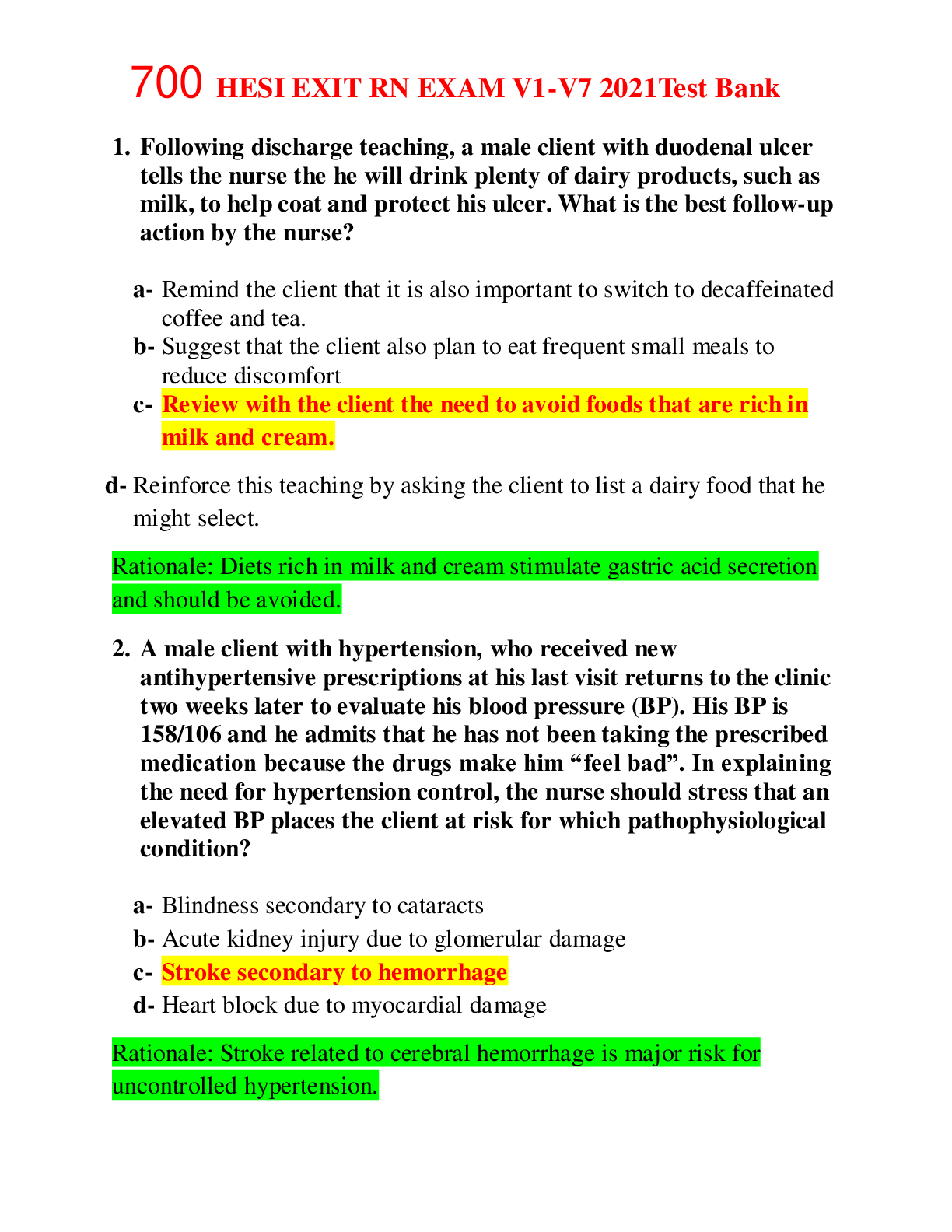

.png)

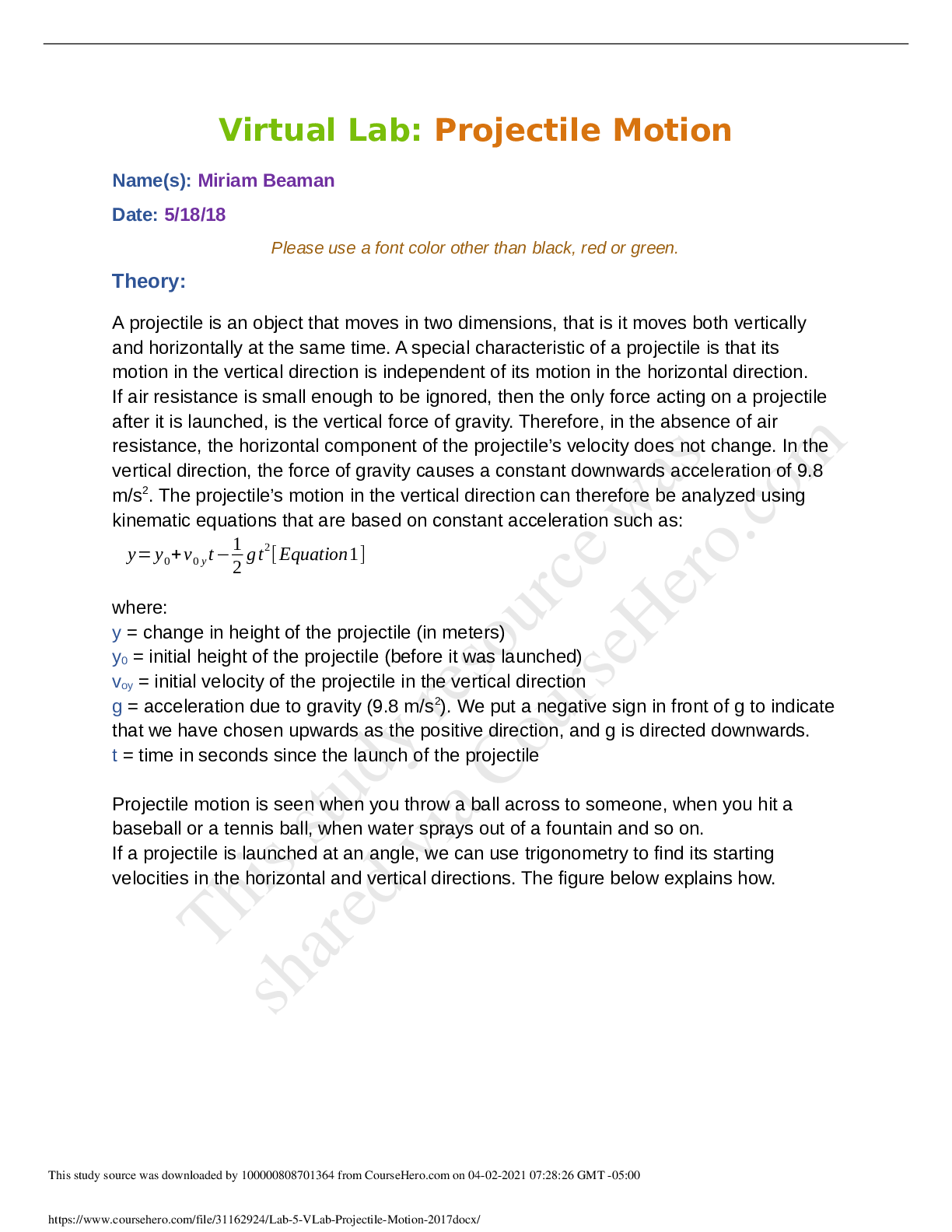

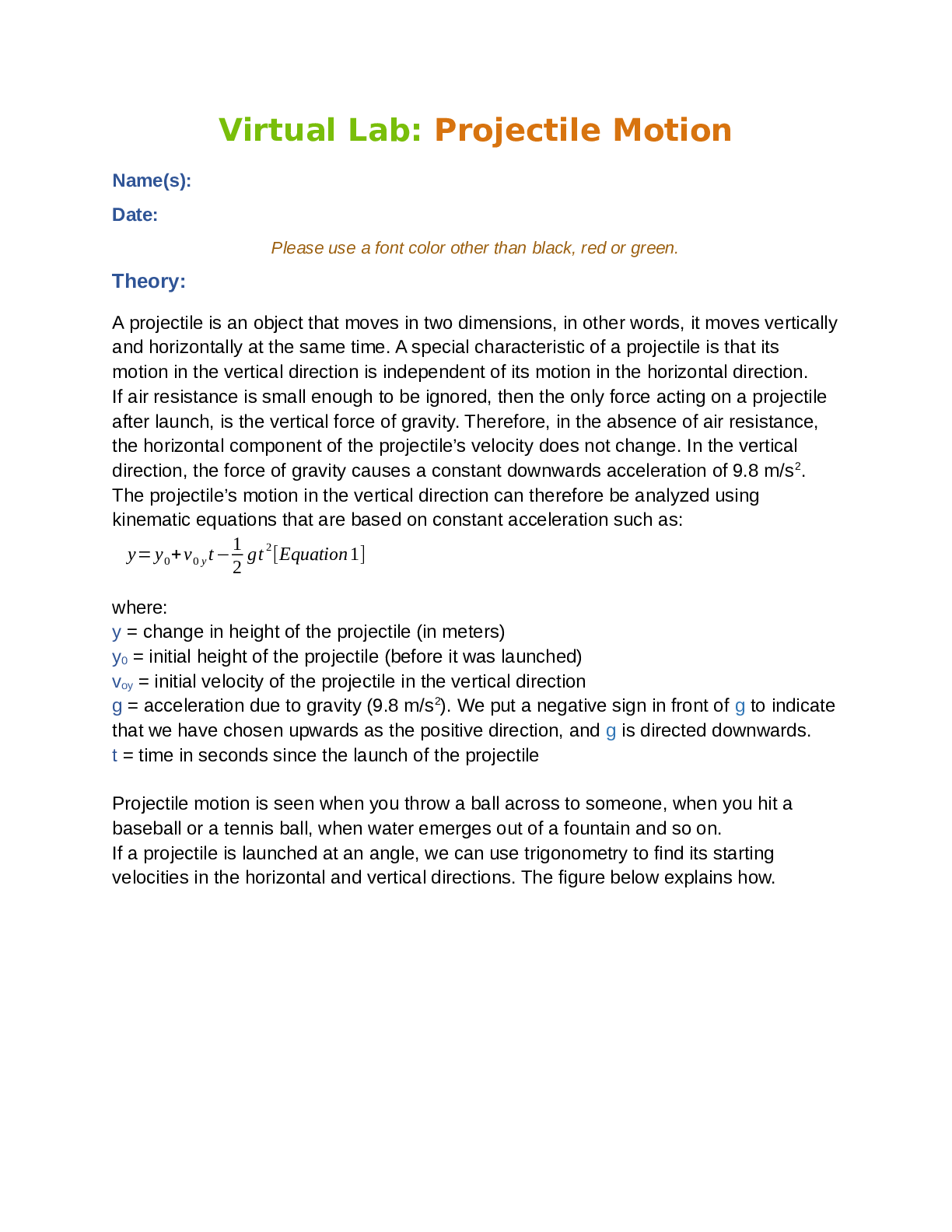


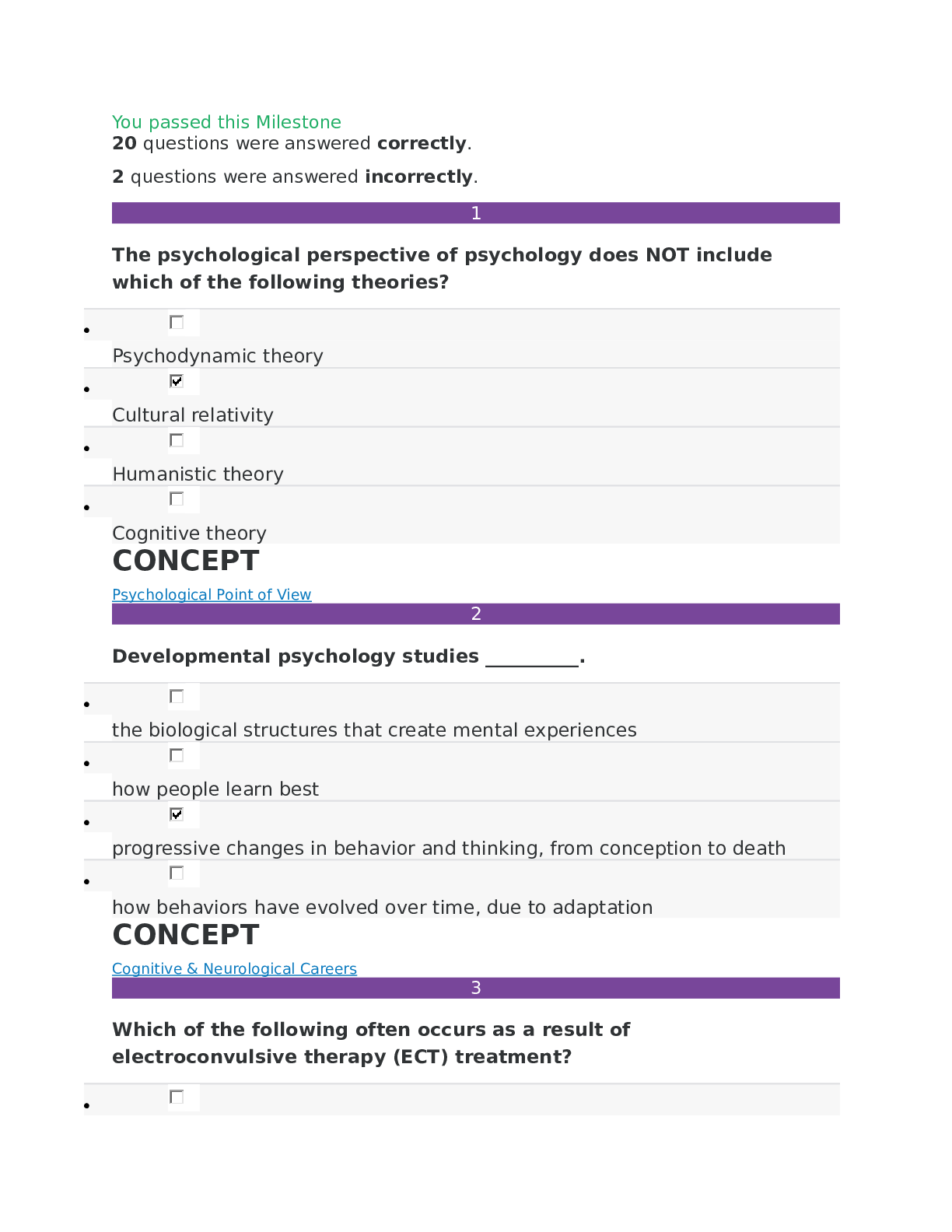

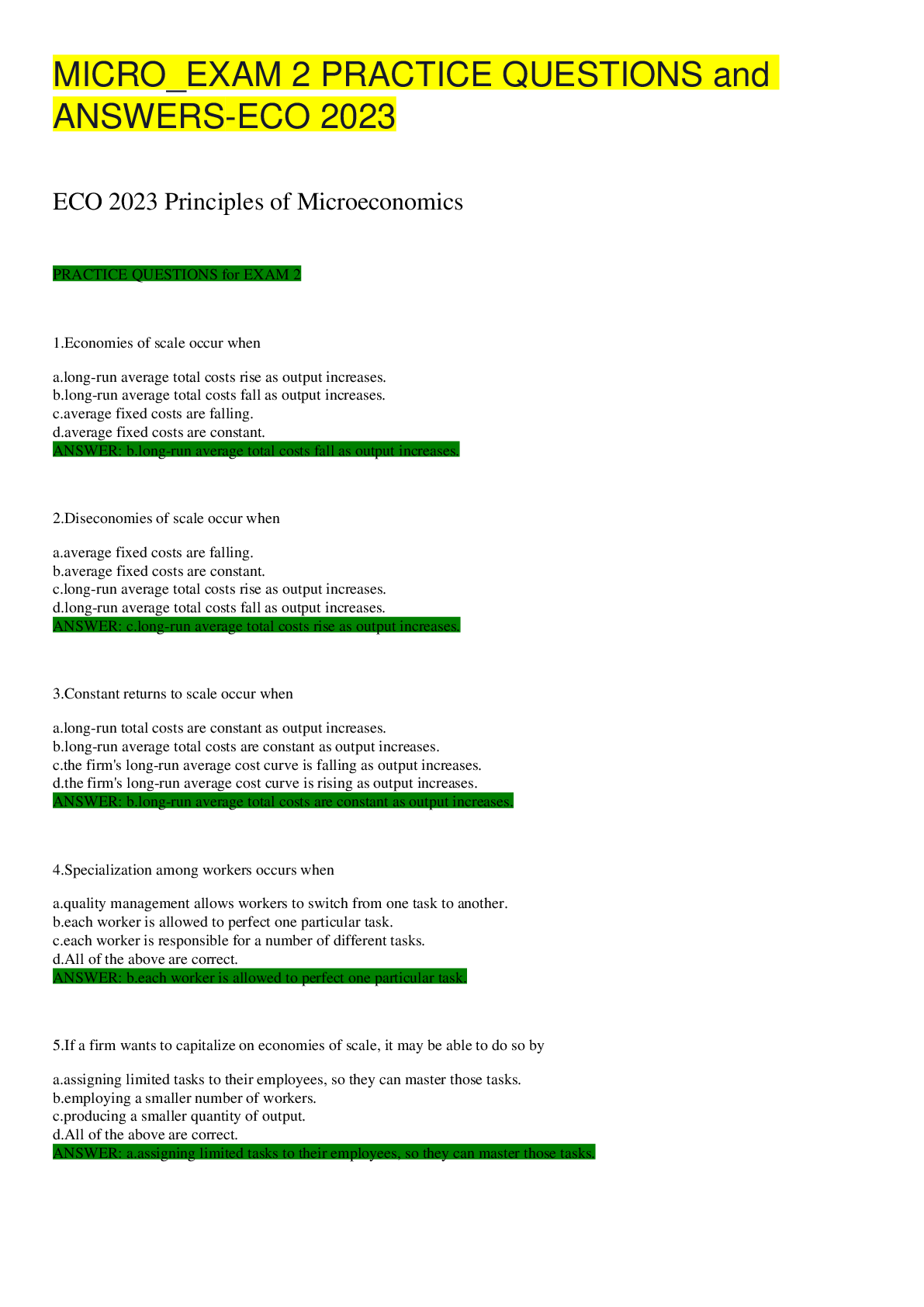

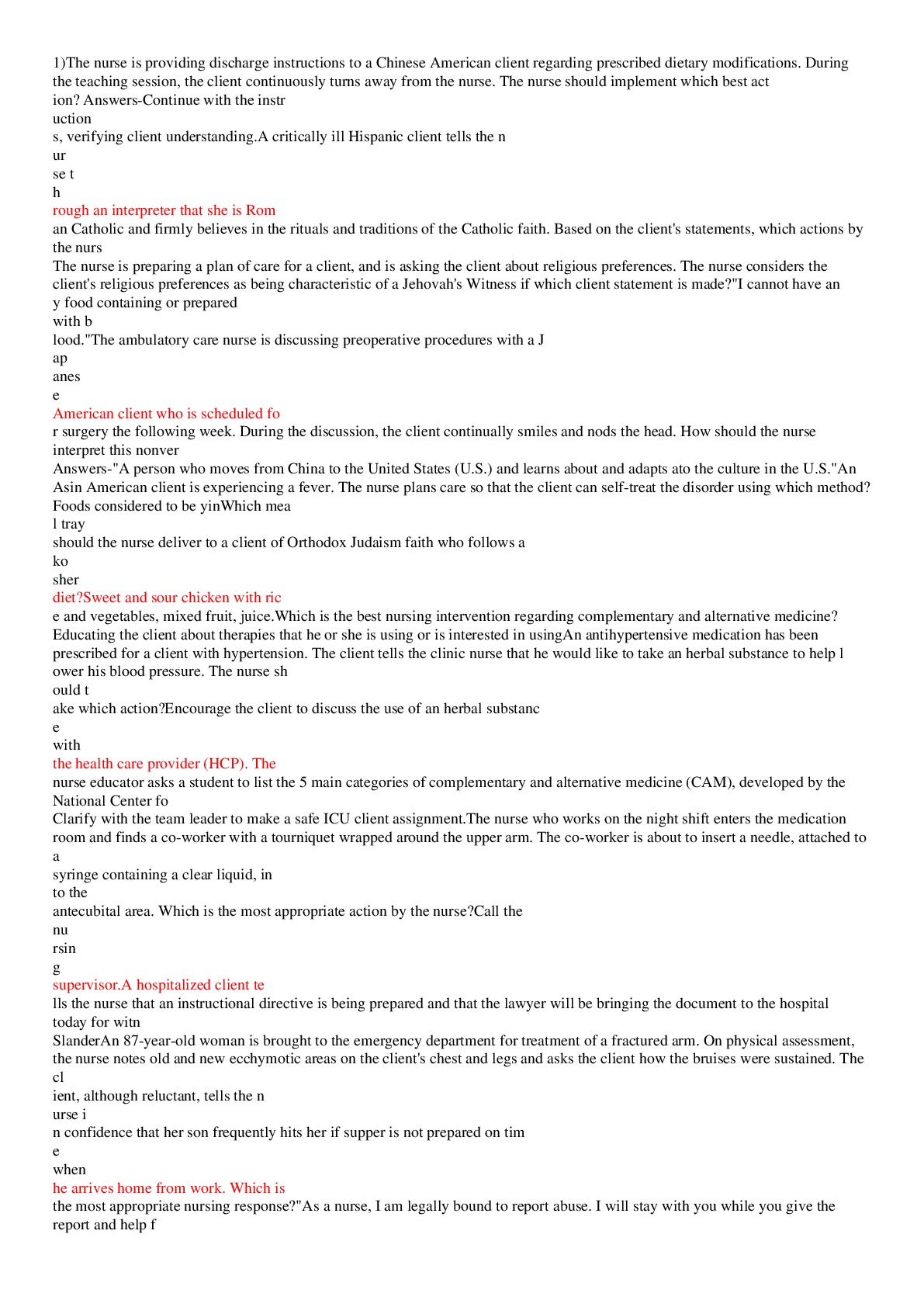
.png)

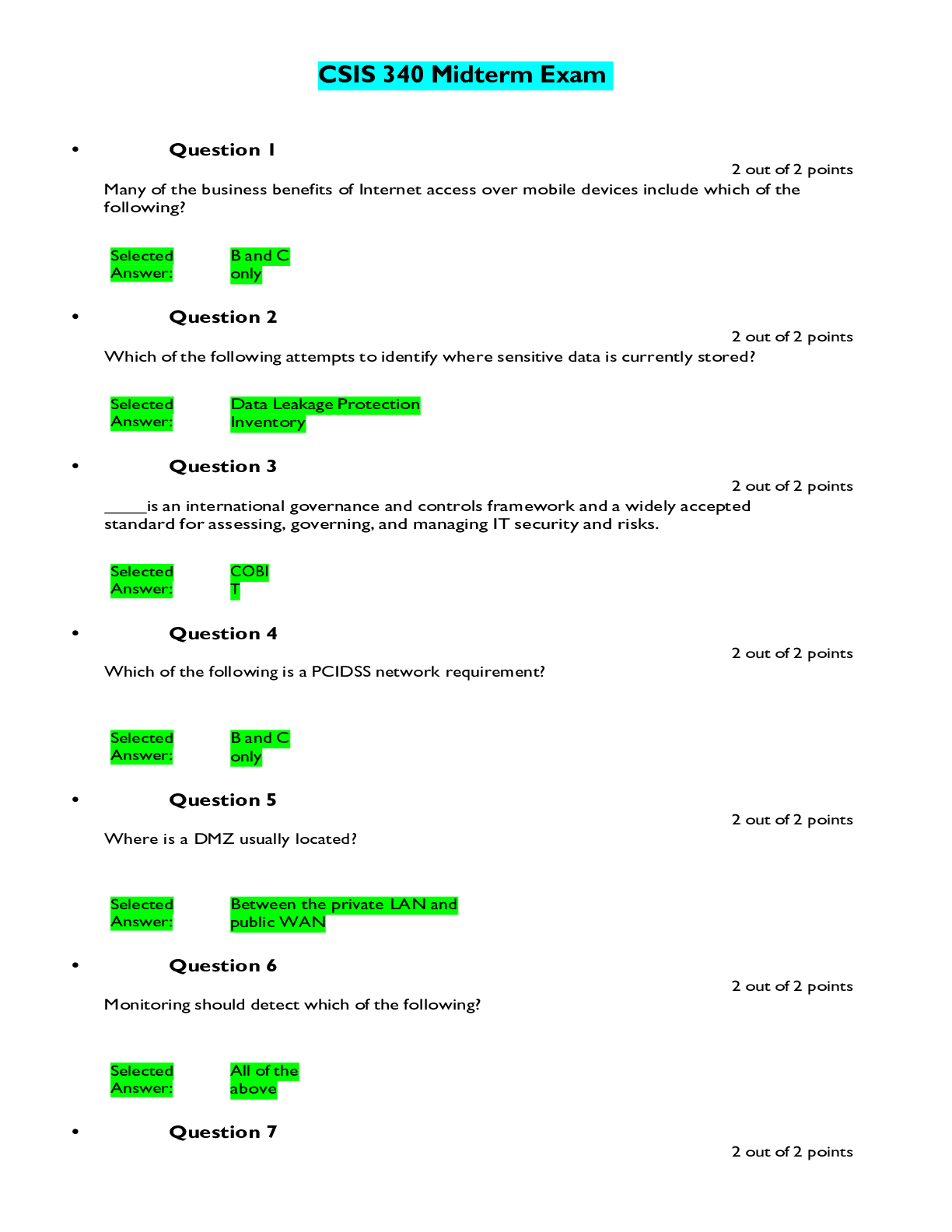
.png)



